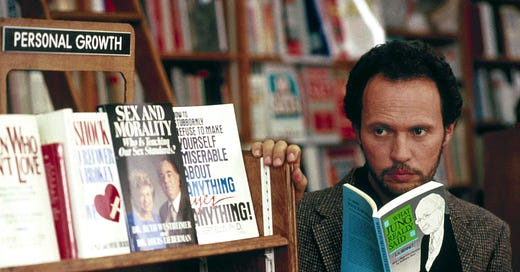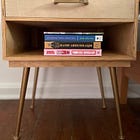The 3 nonfiction books that changed my life this year
Come along on my unintentional personal growth bender
The year-end lists are rolling in and as I started to think about my favorites I knew there were three books that deserved their own post, the lessons becoming part of my daily life. I didn’t set out with a personal growth mission for 2024, it wan’t a resolution. Was it the universe? Or inching toward 40? Maybe a little of both. While the books are vastly different, one common thread is they all made me pause to think about my values and how I’ve been living with, or against them.
January: Wear It Well, Allison Bornstein
“But if your closet is stuck in the past, you might find yourself stuck too. Keeping around the things that you no longer need encourages stagnation on every level. If you are holding onto things that represent past versions of yourself or are trying to make things work that you don’t really love, you’re not allowing yourself to really access who you are and share the best version of yourself. Let those things go.”
Since the pandemic I’ve struggled with what to wear. My days working from home have meant wearing t-shirts aged into the double digits. I found myself at a loss when I did want to wear something outside of athleisure or pajama-adjacent. Cardigans had basically been a pillar of my personality since 2007. But now I would put them on and hated how they looked, how they felt. No longer was I channeling the era of New Girl Zooey Deschanel and ModCloth, where my closet had stayed frozen in time. So who was I at 37 and what did I want to wear? I wanted to feel better in my clothes, still comfortable but slightly more elevated than my college t-shirt. I wanted to easily transition from working, to walking my dog, to cooking dinner. I came across Allison Bornstein on Instagram, (where I watched her TikToks two weeks later like any self-respecting elder Millennial). She outlined useful style tips so when I saw she had published a book, I made the library request.
The new year was well timed for a closet evaluation, and her system is the most effective one I’ve used. You focus first on what you regularly wear — and if that’s sweats, live your truth! From there you make another pile of the clothes you never wear, we all have them (hello, white sequined-collared sweater). You go a step further with your never pile, breaking them into “never-ever,” the “not now” pile, and the “how” pile for the things you love, but you’re not sure how to wear. At the end, you should be left with your regular and the how piles to rebuild your closet. Bornstein walks through how to combine them.
Once your closet is in order, you learn ways to identify your personal style. She has a few methods that are all throughly explained step-by-step and by sharing client stories. The method that resonated with me the most is creating a digital style board: screenshots, saved Instagram posts, or Pinterest pins with outfits or pieces I like. For months I saved images and eventually themes emerged. I now use the style board to help me get dressed and create some go-to outfit formulas that are comfortable and feel like me (a lot of elevated basics and staying true to elastic waistbands).
The style board has also helped combat some of the pull of consumerism, I can shop my closet to create the looks I’ve saved. As someone who likes to second-hand shop, I can stop myself from buying something just because it’s a good find and focus on finding pieces that match my style. Now in December, I’m still tweaking as each season arrives, this has been a year-long journey. It’s also worth noting, Bornstein’s style is nothing like my own but her approaches have helped me find mine and dress for this current version of me (no offense to Zooey Deschanel).
Note: You can subscribe to for monthly style tips.
April - June: The Artist’s Way, Julia Cameron
“Artist brain is associative and freewheeling. It makes new connections, yoking together images to invoke meaning.”
If you’ve been here awhile, you’ve heard about my experience with this 12-week course aimed at unlocking your capacity for creativity. Completing The Artist’s Way was the best thing I did this year. Thanks to the readings and tasks over those 12 weeks, I feel more intentional in my daily life and grounded in creativity. I will gush about my experience to anyone who dares to show the slightest interest, so to keep it succinct, here’s what has really stuck:
Morning pages: (three pages of free-writing each day) and revisiting at the end of the month to see themes, insights and actions.
Daily creative affirmations: “I’m willing to experience my creative energy” and “there is a divine plan of goodness for my work.”
Embracing synchronicity: “We like to pretend it is hard to follow our heart’s dreams. The truth is, it is difficult to avoid walking through the many doors that will open. Get willing to follow it again and a second mysterious door will swing open.”
Prioritizing nurturing of my creative-self: This has meant evaluating my habits, actions, and people in my life.
Don’t just take my word for it, here are a few additional takes on The Artist’s Way:
Surprise! The Artist’s Way is as life-changing as they say from
Blocked Artists And The Lies We Believe from
June: Don’t Overthink It, Anne Bogel
“When we’re overthinking, the easiest thing to do is keep overthinking. To stop the cycle, we need to interrupt these thought patterns, and we can do that by taking a small step in the right direction. Then it becomes easier to take another right step, and another.”
It’s hard for me to imagine someone existing in the modern world who isn’t overthinking. Wait, I probably can, most likely a man. Because, with the fun combo of neuroscience and socialization, overthinking especially plagues women. With the constant information (she types with two laptops open and her phone sitting next to her) and never-ending options, our brains don’t get a break. Combined with people-pleasing tendencies, it’s an exhausting way to live. This book offered simple strategies to dial down the overthinking. Here’s part of what I wrote back in June:
“This had so many great, easy, approachable tips that you don’t have to undergo a personality change to implement. First up, don’t label yourself as an “overthinker,” it’s a behavior—you find yourself overthinking.”
Months later, I credit the chapter dedicated to using values to drive our decision making as the most helpful. Fresh off revisiting my values in The Artist’s Way, this book helped me take it a step further in using them with day-to-day decisions: clarifying objectives, how I spend my time and money, and where I focus my attention and energy.
The other chapter I would vote as most helpful is around the idea of “limiting yourself to free yourself.” For example, if you, like me tend to fall down a research rabbit hole when making a purchase, step back and “limit the source.” So when I needed some new storage containers, I stuck to Target and made my decision within the confines of the one store that had plenty of options. Other ways to limit yourself:
Eat the same thing (this isn’t for me but I can appreciate the suggestion).
Wear the same thing or have a signature look (hello, Wear It Well).
Limit yourself to one time — instead of wondering how you’re going to fit in things like a workout, walking the dog, cleaning, give yourself a routine, regular time to do it.
While I read all of these within the first six months of the year, the changes didn’t happen overnight, it’s been gradual. Do I sometimes only get two pages instead of three in my morning pages? Yep! Did I research across too many sites shopping for base layers recently? Guilty. Do I have a jacket from my “never” pile still in my closet? Of course.
I’m not perfectly checking off all the boxes, but I’m grateful for these three books and where they have led me at the end of 2024. Here’s to staring at someone from the personal growth section of my favorite bookstore in 2025.1
I’ll share my list of top 2024 reads soon, but in the meantime, I want to know: is there a nonfiction book that changed your life this year?
You might also like:
If you didn’t get these references, your first personal growth assignment is to watch When Harry Met Sally.






